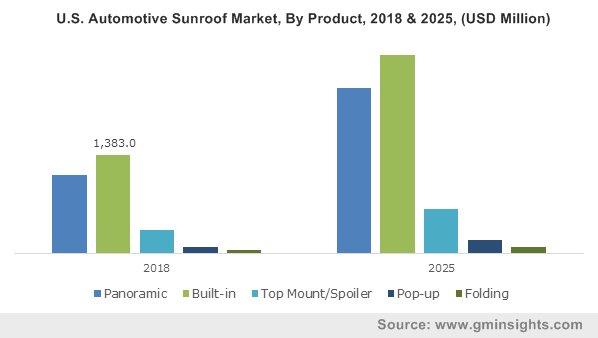India automotive sunroof market to amass substantial revenues by 2025, global industry to gain momentum from rising electric vehicle sales
Publisher : Fractovia | Latest Update: 2019-05-27 | Published Date : 2016-06-16Request Sample
Rapid economic development and increasing focus towards enhancing the aesthetic features of a vehicle has fueled the global automotive sunroof market expansion, securing its position as an extremely prolific investment avenue. Automotive sunroofs have traditionally been a primary feature in luxury or high specification automobiles, although many affordable passenger cars are now offering it across a range of new models. Interestingly, the mainstream media has played a key role in endorsing automotive sunroofs as a visual enhancement, but today their practicality in improving a car’s interior climate through efficient ventilation is being realized more commonly.
U.S. Automotive Sunroof Market, By Product, 2018 & 2025, (USD Million)

Apparently, the biggest hindrance existing for the automotive sunroof market is the probable risk of sunroof ejections during a vehicle rollover accident. However, various OEMs are attempting to mitigate this risk by incorporating seatbelt reminders as well as introducing sunroof airbags, which perform similar to curtain airbags, fostering the development of the automotive sunroof market.
Impact of India’s expanding luxury vehicle segment on the automotive sunroof market
The Conditions: According to the Indian Brand Equity Foundation, in 2017 India became the world’s fourth largest automobile industry, with vehicle sales reaching the 4.02 million mark. To keep up with evolving consumer demands, automakers have made investments for advancing several aspects of a passenger car. The rise in vehicle demand seems to have benefited the luxury vehicle segment as well, with Mercedes Benz, one of India’s largest luxury vehicle manufacturer, increasing its production capacity by more than 20,000 units per year in 2015.
The Culture: Opportunities for the automotive sunroof market are further strengthened by the fact that vehicle sunroofs are increasingly being viewed as a status symbol among Indians, proving the country’s tremendous potential to further accelerate demand for the luxurious feature.
The Growth: Owing to a robust economic growth and a strong customer base, India’s luxury car segment is shaping up to be substantially lucrative. In 2018, Mercedes-Benz had topped luxury car sales in the nation, selling a record 15,538 units, with BMW and Audi selling 11,105 and 6,463 units respectively. Since most luxury vehicle OEMs provide a sunroof option for nearly all of their products, the automotive sunroof market would undoubtedly be experiencing a steady rise in demand over the forecast timeframe.
Impact of rising electric vehicle sales on the automotive sunroof market
Electric cars had generally been considered as a minority segment within the automotive industry, as they were often underpowered and had ranges that made them quite impractical for commuters. The segment has now transformed considerably with companies like Tesla making significant advancements in electric vehicle technologies.
The Conditions: Effective technological advancements have allowed electric vehicles (EVs) today to actively compete with conventional automobiles and acquire a larger chunk of the global automobile industry. Reports confirm that Tesla is outcompeting luxury vehicle manufacturers in the USA, wherein its 2018 third quarter sales were recorded at 83,500 units in 2018.
The Difference: Sunroofs, especially panoramic sunroofs are often considered risky in conventional automobiles since they are prone to being shattered during a roll over crash. In electric vehicles the roll over risk is largely mitigated because they store their heavy batteries into the floor, which lowers the cars center of gravity.
The Need: While batteries lower the center of gravity in an EV, they also make it heavier than compared to conventional automobiles. In fact, a Tesla Model X weighs approximately 2,509 kg (2.5 tons) and a Nissan Leaf hatchback weighs around 1,557 kg (1.5 tons). To counter the effect this weight gain has on the vehicle’s performance, many EV manufacturers are adopting panoramic sunroofs to lower their vehicles’ curb weight, which would significantly transform the automotive sunroof market dynamics.
Propelled by growing luxury automobile sales in emerging economies like India and augment demand for EVs worldwide, the automotive sunroof industry is projected to accrue substantial gains over the forecast timeframe. Reports estimate that the global automotive sunroof market will exceed a valuation of US$40 billion by 2025.